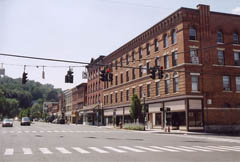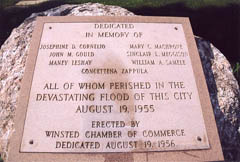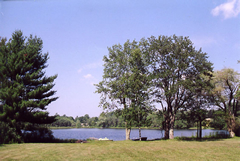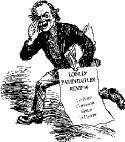August 5, 2021 --
By the end of the first week, summer life at Wabigoon had settled into a routine: the day beginning with Reveille, then morning lineup, breakfast, inspection, morning activity, morning swim, lunch lineup, rest period, milk and cookies, afternoon activity, afternoon swim, evening lineup, dinner, evening activity, Taps.
What would the Woke generation say of our communal showers in the shower house, beneath the mess hall? Our bunks had indoor plumbing, but the water was not drinkable. For drinking water we filled canteens at the water fountain next to the Wahanda entrance to the mess hall.
Counselor days off began the second week of camp, with counselors going to Winsted, or Torrington, or Tanglewood, or, maybe, even, Boston. The counselor curfew was midnight. The waterfront counselor always got Wednesday for his day off. Most counselors took Tuesday or Thursday for their day off. Few chose Mondays. No days off Friday through Sunday. A good tip for a coiunselor for the season would be $20. I thought I was being extravagant purchasing a cord suit at Meyer's on Main Street for $40.
Softball and basketball games with other camps were played from the third through the sixth weeks. The boys' circus was the last Sunday in July; the girls' circus was the second Sunday in August, after which Color War usually broke -- the athletic climax of the camp season. The "circus" came in two parts: the acrobatic performances by each of the groups, followed by the bunk concessions, with the money raised going to the UJA. The concessions included games of chance, dunk the counselor, "marriage" ceremonies with time for a "honeymoon." One year, a senior bunk built a miniature golf course, alongside the bunk, as its concession.
The bunks had screens and flaps instead of glass windows. (The only glass window was in the rear of the bunk, above the "john".) Clothing was stored in cubbyholes, with our trunks placed in the rafters above the cubbyholes. Accommodations were not primitive, but they weren't luxurious either. Wabigoon prided itself on its "spirit," which made do for the absence of hot water in the bunks.
The Wabigoon spirit was also in evidence the weeknights when the activity was "Spell It Out." Originally, the senior group was divided into two sections, along with the rest of the groups, but the "Spell It Out" questions were directed at the seniors who stood in a circle, working out the answer. Not infrequently, the seniors being stumped, a younger camper, holding his letter, would run up to the circle, offering his considered answer to the question. The two sides in "Spell It Out" consisted of a combination of the Watermelon League teams, Mondays after dinner being the occasion of Watermelon Leagiue events, Wabigoon being divided into teams headed by a counselor who named the team for his univerisity. There were from six to eight temas iin the Watermelon League and, yes, at season's end, the winning team got a watermelon as its prize. Bunks that had the highest weekly inspection numbers (ten being the highest) got six ounce bottles of Coca Cola as reward. Bottles of coke were also handed out as rewards for actions, feats, accomplishments beyond present recall. Another drink having some popularity at Wabigoon was Kool-Aid.
Saul "Rusty" Grant was EWabigoon head counselor most of my years as camper and counselor, One summer, Rusty applied was a major change in "Spell It Out." this intellectual as sport activity: henceforth questions would be directed to each of the groups, standing in a circle taking in the questions, with the largest number of questions directed at the seniors. "Spell It Out" was never quite the same. Still, I fondly recall a time , in 1957, when my team in a Color War "Spell It Out" answered a few questions with the efficiency of a well-oiled machine, quietly organizing the answer so that the campers held their letters arrayed perfectly, while the opposing team was stumped and a bit in awe as the correct answer was, well, spelled out at the stage-end of the boys' rec hall.
The Big Show -- a musical performed by the senior groups of Wabigoon and Wahanda -- was presented the second Saturday night of August, with the girls' circus the next day, and Color War breaking after the Wahanda circus.
Color War covered three chock-full of das of events, with the limited spare time left for learning the songs for the Sing event that concluded Color War. LPR imagines that in these Woke times, the very term "Color War" would be in disfavor. Originally, the team songs were sprinkled in the Presentation, which had been the closing Color War event, until the mid-50's. Presentations were elaborate playlets, attesting to the prowess of the Green team, over the White team (the camp colors being green and white) -- and vice vera. My first year at Wabigoon, in 1947, as a seven year-old freshman, I was on the Green Gremlins, against the White Musketeers. (The Gremlins won that Color War). |
The Gremlins' Presentation had something to do with a simulated plane crash, the plane going from a tree at the edge of the softball field, crashing to the ground in flames -- something like that. With a memory going back three quarters of a century, I always was more impressed with the Musketeers' Presentation and recall that their marching song went to the melody of the triumphal march from "Aida." I have no recollection of any of the Gremlin songs.
 |
A
view down Main Street in Winsted. |
 |
Memorial
to the victims of the Flood of 1955. |
In 1955, we had Hurricane Carol the days up to the Color War break, and then, at that Color War's end (the White Olympians defeated the Green Pagans -- I was a Pagan), it started to rain, continuing all through Thursday -- Hurricane Diane.
 |
The
Camp Wabigoon waterfront on Rowley's pond as seen from
left field on the old Wabigoon softball field. A fly ball
in the lake was usually a home run (unless, in going around
the bases, the runner missed second, as this writer once
did--the one time he hit a ball into the lake.) |
The combined might of the two hurricanes devastated a swath of the northeast, from Pennsylvania to New England, including Winsted, where the Main Street was turned into a ravine, cutting buildings in two as if they were doll houses. The culprit was the ironically named Mad River, a stream that ran alongside Main Street, behind the structures on the south side of the street.
There no longer are structures between Main Street and the trickle that is the Mad River. In Winsted, the flood of '55 took the lives of seven people, in a city of 8,000. John Hersey wrote about the catastrophe which, probably, would, today, be blamed on climate change.
Typically there would be little more than a week between the end of Color War and the end of camp, August 26. The senior prom would be held on August 23. On August 24, the season-ending banquet would be heldm at which the awards for best athlete and all around camper by groups would be announced, leading up to the awards for best athlete at Wabigoon, followed by the All Around camper award. Similar awards were announced for Wahanda's campers, as well.
After the banquet for Wabigoon and Wahanda, the burning of the CW. The last night of camp, Wahanda had a ceremony without a Wabigoon counterpart. The girls would float candles placed on wooden squares onto the lake -- Rowley's Pond, actually -- with a waterfront shared by the two camps. On returning to the New York metropolitan area, seniors from both camps might meet up and go to Forest Hills for the U.S. Tennis championships -- which, in those years, was strictly an amateur event.
Wabigoon, on top of a hill above Winsted, Ct., from where in those years, three rolling Berkshire hills in nearby Massachusetts were visible to the north. Where the day's air was redolent with the aroma of incredibly sweet grass, and most nights were cool; then, well into August, becoming even cold at times, with a sparling canopy of stars above -- look here, the Milkway Way, look there, the Big Dipper, and see Orion's belt. And on full moon nights -- a bright lantern to light the way of the sneakout assignations of senior boys and girls, heading, about 1 a.m. to farmer's field, next to the camps, careful not to awaken the counselors.
The summers of some very fortunate boys and girls -- and young men and women, too.
|
|



